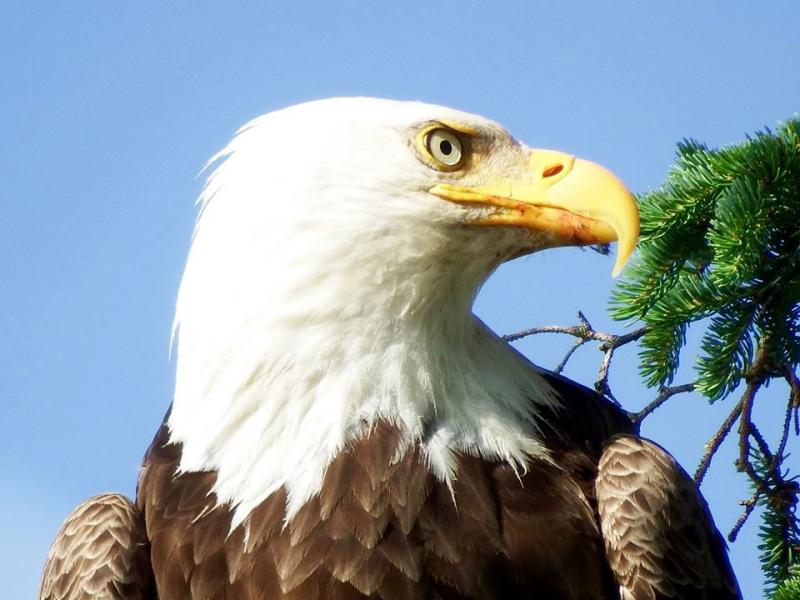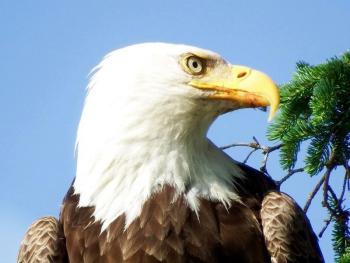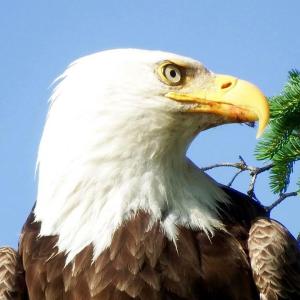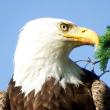Maine’s Largest Bird
Where we live, it’s pretty common nowadays to see bald eagles at any time of year, quite often flying very low over the house, soaring at easy viewing height over the grocery store or post office, or just about anywhere. But it never stops being a thrilling experience, seeing one of these majestic birds up close such that we can really appreciate how massive they truly are. In fact, bald eagles may be the largest bird that occurs regularly in Maine. That is, depending on how you define “largest.”
When you look at lists of the world’s “largest” birds, you find that the lists differ depending on whether you define “largest” as being the heaviest, having the largest wingspan, being the longest (usually measuring tip of bill to tip of tail), or tallest (including the legs). The world’s heaviest birds are flightless birds, with ostriches at the top of the list. They can regularly weigh in at over 200 pounds and occasionally up to 300! Others that top the heaviest-birds-in-the-world list include other flightless birds like cassowaries, emus, penguins, and rheas.
Maine’s heaviest bird would almost certainly have to be the wild turkey that here in Maine can be 15-20 pounds, with occasional birds up to 24 pounds. The only bird here in Maine that comes close to that weight would be mute swan, which is an introduced species and occurs only very occasionally in ones or twos in southern Maine. Going down the list in terms of weight for Maine birds, there’s the sandhill crane, Canada goose, bald eagle, and common loon all hovering around the 9- to 11-pound category.
Most people probably think of wingspan as defining the “largest” bird, in which case the bald eagle does take top honors here in Maine if considering only regularly occurring species (otherwise the rare pelican or albatross would beat it out) with a wingspan of around 80 inches, or a little over six and half feet. The bird with the largest wingspan on Earth is the wandering albatross at around 12 feet—nearly twice the wingspan of a bald eagle! Here in Maine the sandhill crane comes in a close second at 77 inches followed by a tie for third place between great blue heron and northern gannet at 72 inches, with turkey vulture in fourth at 67 inches.
Maybe it’s because we can get closer to gulls than to other large birds, but we generally think of a bird like a great black-backed gull as being very large. And they do come in pretty high on the list with a wingspan of about 65 inches, though they are a relative “lightweight” at about three and half pounds. Still, that makes them the largest gull species in the world and pretty formidable! We still remember University of Maine/Farmington biology professor Ron Butler describing how, when banding a great black-backed gull, he made the mistake of letting go of the bill for just a second. The bird thrust its lower mandible into his mouth and tightly clamped it closed on his cheek. Imagine trying to yell for help with your cheek in the vise-like grip of a black-backed gull’s bill! In such a case, that bird would probably seem to be the strongest, if not the largest bird there ever was!
Jeffrey V. Wells, Ph.D., is a Fellow of the Cornell Lab of Ornithology. Dr. Wells is one of the nation's leading bird experts and conservation biologists and author of the “Birder’s Conservation Handbook.” His grandfather, the late John Chase, was a columnist for the Boothbay Register for many years. Allison Childs Wells, formerly of the Cornell Lab of Ornithology, is a senior director at the Natural Resources Council of Maine, a nonprofit membership organization working statewide to protect the nature of Maine. Both are widely published natural history writers and are the authors of the book, “Maine’s Favorite Birds.”
Event Date
Address
United States


























